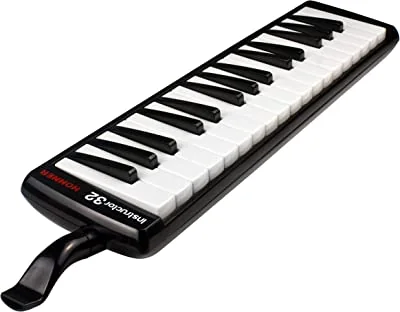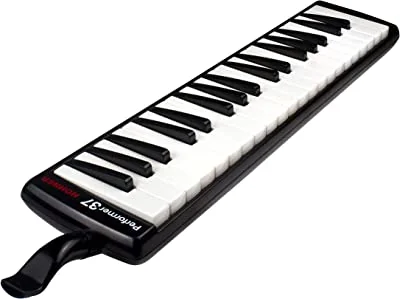Aaah, weird and wacky instruments! Part of the joy of being a musician is the sheer number of interesting instruments out there. You can stick with your primary instrument, like piano or guitar; but sometimes it’s fun to try out something brand new.
The melodica is one such instrument. While historians could argue that Italians were making them over one hundred years ago, modern ones were invented just over sixty years ago.
Top 3 - Melodicas
While relatively new to the music world, they’ve been adopted by a wide array of musicians. Most recognizable is Jon Batiste, the bandleader and jazz pianist for Steven Colbert’s talk show.
Other notable musicians include funk keyboardist Bernie Worrell, minimalist composer Steve Reich, YouTube sensations Walk Off the Earth, and reggae musician Augustus Pablo.
In this article, we’ll be looking at six of my favorite melodicas that I've used extensively. Then, we'll delve deeper into the basics, the history, modern use cases, the various tiers of melodicas and various other actionable tips.
Best Melodicas - My Favorite Models
1. Suzuki M-37C Melodica
While the RASTA melodica listed later is certainly the most unique item on our list, the Suzuki M-37C melodica includes some excellent features. While staying in the medium price range, it sports a design that pushes it close to top-tier quality.
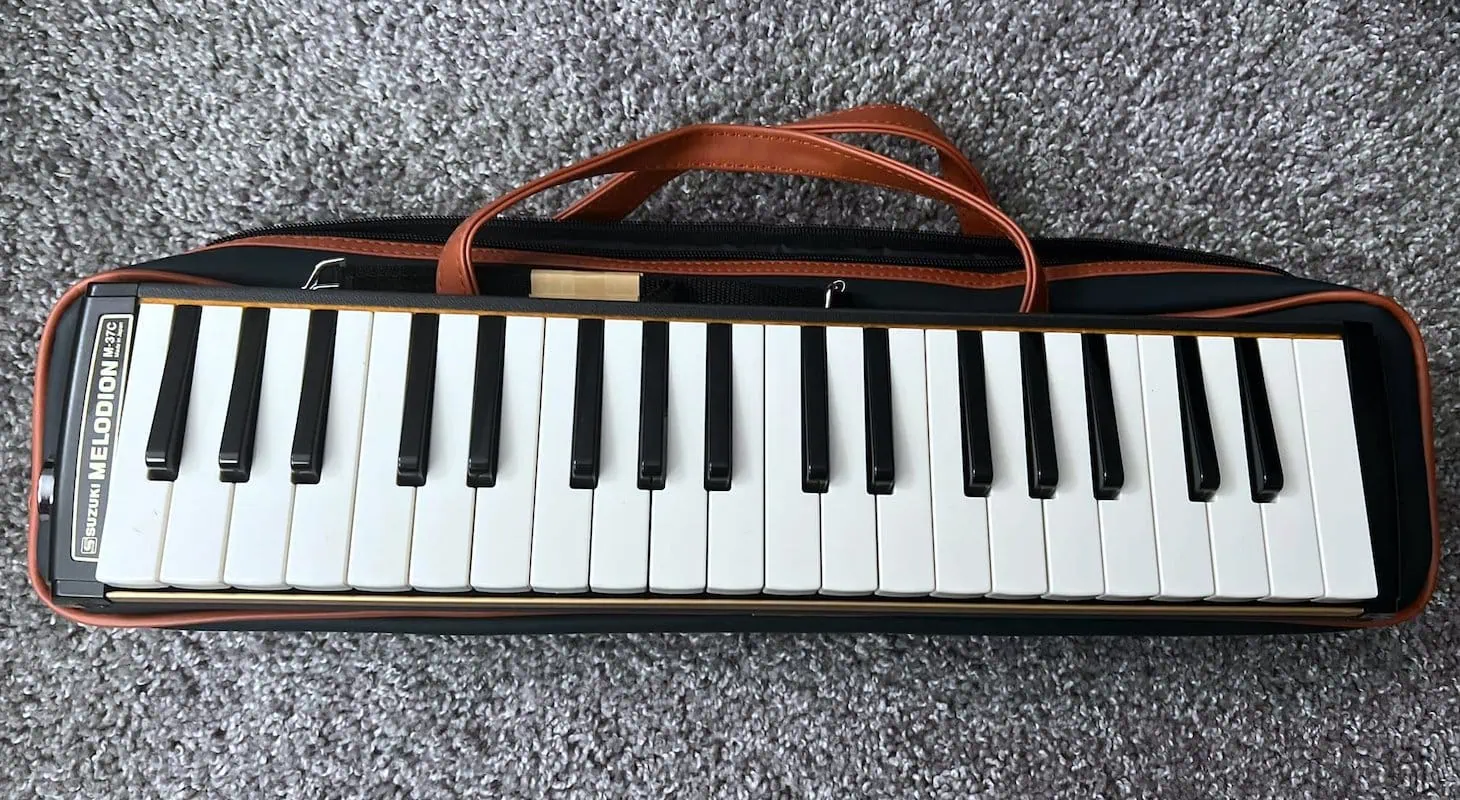
Suzuki M-37C Melodica
Suzuki did a stellar job at delivering numerous quality features. They complete the keyboard with three full octaves (F to F), and the reeds are made with bronze – a material that’s more resilient than the typical brass.
The body itself is aluminum, a clear upgrade from the plastic used by other models. The keys themselves feel solid and responsive. All these features work together to create a robust sound that belies its purchasing price.
Lastly, two other interesting features are worth mentioning. First, Suzuki shaped the mouthpiece like a trumpet. This increases expressiveness and, to a degree, limits the amount of saliva that enters the instrument.
Second, the complementary case is metal and robust. Most, if not all, melodicas come with a complimentary case. However, most of them are not as tough as the M-37C’s.
For what it’s worth, the extra protection certainly adds value to an already remarkable product. All factors considered, the M-37C is a great first choice for serious musicians who want to start cheap with the melodica.
Suzuki has a long history of making reed-based instruments and organs, and for a brief period, they ventured into electronic gadgets as well. One particularly interesting instrument is the Omnichord — essentially their electronic synth version of the melodica.
The instrument is delightfully quirky and popular in indie folk music, while also enjoying a revival in lo-fi electronic music and hip-hop. Money Mark of the Beastie Boys frequently uses the Omnichord to create unique, strum-like melodic passages. Imagine this instrument as a blend of melodica, arpeggiator, and analog synth.
I love the Suzuki melodica primarily because its sound lends itself extremely well to processing through electronics. On its own, it has a very reed-like, accordion sort of sound, but the moment you start running it through guitar pedals, everything changes.
This is probably one of the reasons why melodicas were used extensively in reggae music. Many reggae tracks featured acoustic instruments processed through the Roland Space Echo, a tape machine-based delay unit that became legendary for adding sweet distortion to the tape feedback delays.
It was also famous for having a quirk — actually a mistake — where turning the feedback knob past a certain point would create endless feedback until it turned into pure fuzz distortion. You'll hear this echo effect not just on reggae vocals and guitars, but also on woodwinds and reed instruments.
I've extensively used melodicas through space echo units — particularly the Roland Space Echo — in my sound designs for feature films and TV loops. Many composers, including Jon Brion and Nathan Barr, have experimented with the Suzuki melodica as a sound source for ambient cinematic patches.
I completely understand why — I often use it to create a hybrid between a reed organ and a woodwind orchestral section, passing it through lush ambient effects like the Roland Space Echo and Strymon Deco.
Playing this melodica through its optional rubber mouth tube produces a breathy tone, creating hypnotic sounds perfect for lo-fi indie rock, film scores, and beyond.
Among all the melodicas, the Suzuki M-37C sounds the most modern to me. This works well for processing because it often sounds like a vintage organ when mic'd up at certain dynamic levels. It also has a more pristine sound compared to other reed instruments.
I suspect it's the overall architecture and balanced output of low and high harmonics that creates this effect — making it sound almost pre-EQed or like it's captured through a guitar pickup. While it's clear and usable on its own, once processed as described above, it reaches another level entirely.
2. Hohner 32B “Instructor” Melodica
The Hohner 32B, or “Instructor” for short, is the cheapest melodica on this list. It’s a great choice for hobbyists looking to experiment as cheaply as possible.
Despite the cheap price, the Instructor is a fantastic melodica to start on. Why? It’s simple – Hohner invented the modern melodica in Germany! They’re synonymous to melodicas, like Fender is for guitars and Yamaha is for pianos.
Like all melodicas, the Instructor includes a built-in hand-strap and spit valve. The hand-strap allows you to hold it while playing, as opposed to laying it flat on a table. And since it’s played with your breath like a clarinet, the spit valve is essential to keeping it clean and usable.
The mouthpiece bends a bit, allowing a natural angle between the keyboard and your mouth. However, if you want to extend it, a rubber tube is included as well.
The keyboard extends two full octaves, plus a perfect fifth (hence the 32), starting on F and ending on C. This range is admittedly smaller than most models, but still suits beginners well.
If you’re wanting a wider range though, you’re in luck: the next model is a souped-up version of the Instructor!
I've always found the Hohner sound to be darker than its competitors like Suzuki and Yamaha — the Japanese brands tend to have a brighter, more cutting tone.
The 32B Instructor melodica has a warmer tone, and its curved mouthpiece makes it particularly expressive.
At low volumes, playing chords on this melodica creates a beautiful, subdued woodwind section sound that's perfect for film scores. It also offers exceptional clarity for melodies, especially in the lower range.
One reason I own the Instructor is that its curved mouthpiece creates interesting recording opportunities in the studio — you can capture the center body in stereo or the instrument's end through a mono mic.
Here’s another unique tip: When recording, I position a microphone near my mouth, slightly off-axis and higher up. This lets me play the melodica while singing along with the melodies, creating a quasi-polyphonic texture as my voice naturally detunes against the reed sounds.
This creates a fascinating sound when captured properly.
Being a fan of electronic processing and synthesizers, I add another layer to the Hohner Instructor recordings. After recording a good take of melodies or chords, I run the audio through my Behringer VC 340 vocoder.
I then play lush chords and blend the direct DAW signal with the vocoder's sound. This creates an engaging hybrid of organic and robotic textures.
The result is especially impressive when capturing the vocal mic's humming, as it triggers extra harmonics in the vocoder, creating a musical, fuzzy high tone.
For those unfamiliar, the Behringer VC 340 is based on the Roland VP 330 vocoder, famously used by Daft Punk on their hit "Get Lucky" with Pharrell.
Roland has always excelled at chorus effects. Their Juno-106 synthesizer, Juno-60, and vocoder featured an amazing ensemble effect similar to the Roland CE-1 vintage pedal and their Dimension rack unit, made famous by Andy Summers of The Police.
Behringer modeled this circuit and used a custom-made analog chorus ensemble for their VC 340. When triggered with the vocoder sound and blended with the melodica, it creates an incredibly lush, pad-like sound.
The chorus widens and tames a bit of the reed-like quality of the Melodica, making it sound much more appealing and modern.
The result is remarkable — though difficult to describe without hearing it. It has an analog quality reminiscent of a Yamaha CS-80, with a cinematic touch while maintaining its organic character.
Running this through an Eventide Harmonizer or an H90 pedal, adding reverb and modulation, creates something that can enhance any track, in any genre.
If you ever get a chance to experiment with a melodica and vocoder, whether it's a plugin or this analog vocoder from Behringer, try this technique — it might become one of your favorite sounds.
3. Hohner S37 “Performer” Melodica
If you like the Instructor melodica, but know you will want more playability, the Hohner S37 Performer is for you! Like the Instructor, you can simply refer to it as the “Performer.”
Both are part of the same series. As is obvious from their titles, the Instructor is geared towards learners, while the Performer gives learners more space to actually gig with it.
Because they’re in the same series, both melodicas look the same. The biggest differences are related to their build quality and range.
The Performer extends the range to a full three octaves, starting and stopping on F. The keys and springs inside react slightly faster to your fingers, making it more reliable for live performance.
Additionally, the Performer has a slightly fuller, accordion-like sound. Its sales page says it’s ideal for “jazz, pop, rock, and reggae.” All these descriptors fit my list at the beginning of this article perfectly!
This Melodica has an extended low range — a great combination that makes it similar to a mini bandoneon. For those familiar with the bandoneon, it's like an accordion, but when played on the player's lap, it produces a smoother, warmer, and slightly more percussive sound than a regular accordion.
That's how I feel about the Hohner Performer — it has a wonderful attack on each note without being harsh or too percussive. This makes it ideal for playing melodies, and it works amazingly well for country music and jazz.
I've used it extensively in these genres, usually with minimal processing — just a bit of compression and perhaps some harmonic saturation to give it a '60s organ-like presence. On indie rock, I've used it for interludes and song intros where you want something between the funkiness of a fiddle or banjo and the sweetness of a flute or recorder.
That's where Melodicas find their niche in production and songwriting — they create clear melodies without being too distinctive or immediately identifiable. In modern production, this is exactly what many producers and artists seek: something raw, organic, and acoustic, yet mysterious in its origin.
Since Melodicas are rare in modern popular music, you have a great opportunity to create something unique.
I mentioned the Performer's great attack, which isn't surprising since Hohner also made the original Clavinet in the '70s — heard prominently in Stevie Wonder's classic "Superstition."
Though the Clavinet uses a completely different mechanism, being more of a plucky, dulcimer-banjo-type instrument, this Melodica's transients are definitely more pronounced than other models.
Here’s a production tip: When processing this Melodica, it's fascinating to play chords through a wah-wah pedal. Whether in the studio or live, routing it through a wah-wah pedal and reverb straight into a guitar amp creates some interesting organ/Wurlitzer-type sounds.
Given this Melodica's great attack — considering it's a reed instrument — and depending on how you blow into it, it has a nice presence that allows for more groovy and funky playing than others.
I've used this live for solos, adding effects like a Fulltone OCD into a Strymon BlueSky reverb. It captured that Herbie Hancock classic funky power amazingly well.
A fantastic studio technique is running it through the Fulltone Mini-Déjà Vibe rotary speaker pedal. This pedal beautifully emulates a Leslie speaker. When combined with vintage chorus, playing soft chords through the Performer creates rich, dreamy organ pads.
These effects work in any style of music — I've even used them in modern pop and dance instead of synth pads. It sounds cool because you can make it more dynamic through your breathing technique, something impossible with synthesizers.
The best you can do with synths is use a volume pedal or assign CC parameters for modulation to touch strips for a dynamic ebb and flow, but it doesn't compare to a real acoustic instrument like the Melodica.
The Performer is incredibly versatile for both live and studio use, and it maintains its tuning exceptionally well thanks to its solid build. It stays in tune longer than the Instructor, which is Hohner's more entry-level model.
4. Yamaha P37D “Pianica” Melodica
Sitting comfortably in the medium price range, Yamaha’s “Pianica” melodica includes unique features not typically found in similarly priced models.
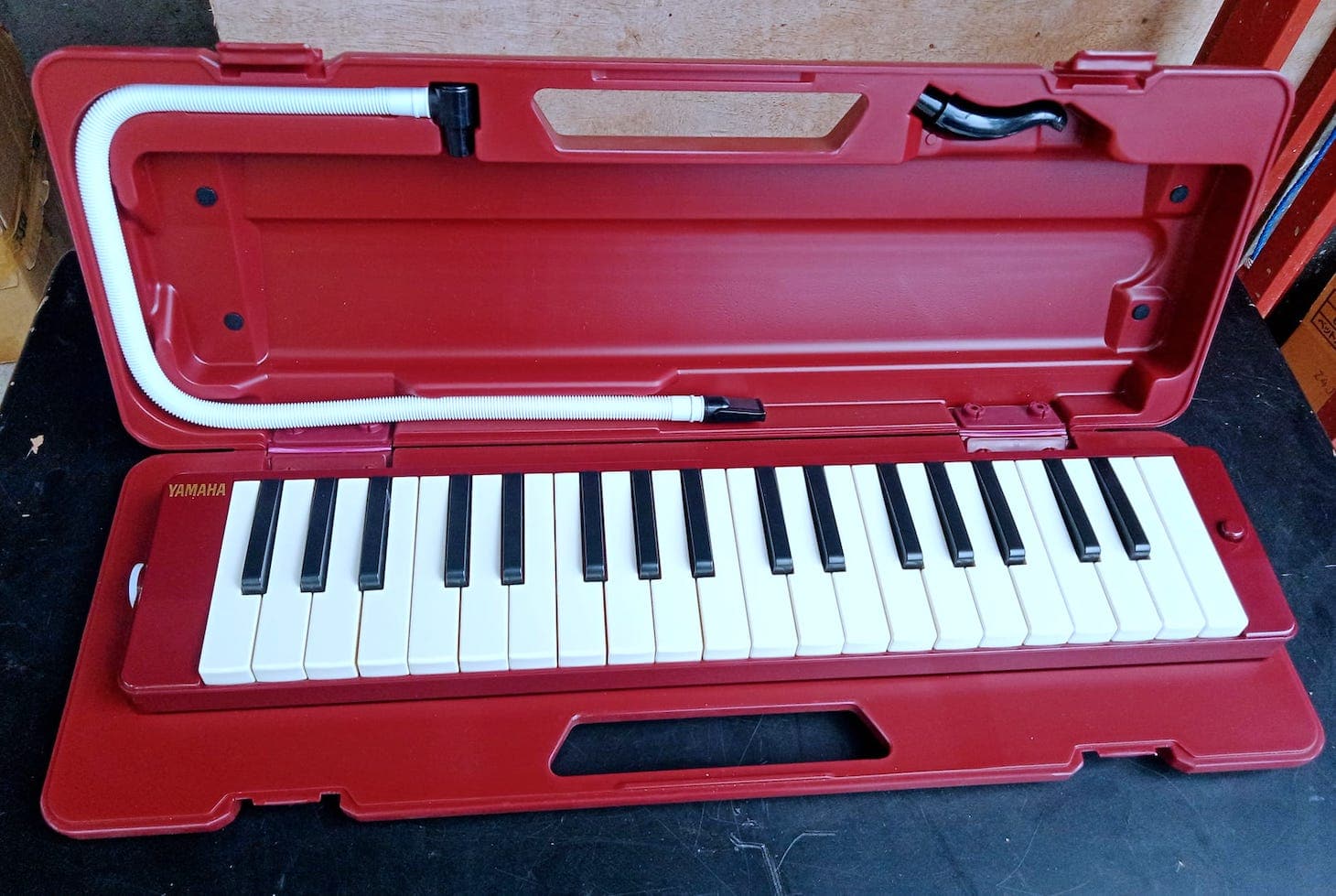
Yamaha P37D Pianica Melodica
While the Pianica’s body is made of plastic, it also includes rubber and brass. It’s body is still sturdy, and it extends to the full three octave range (as usual, from F to F).
Admittedly, I find its complementary case rather comical; it’s made of perfectly robust plastic, but its shape makes it look more like a toolkit than an instrument case!
I’m not sure why Yamaha got so carried away with its strange shape, but it’s officially the toughest case in our list! The only downside is it doesn’t have extra pockets; a tiny detail, but worth mentioning.
So, what makes the Pianica unique for its price? First, it includes plugs for shoulder straps, a feature that’s usually included on higher-end models. Second, it has astonishingly good key action for its price!
Third, and most importantly, this is one of the most powerful-sounding melodicas volume-wise. It takes very little air to produce a full, loud sound while still maintaining dynamics. While perhaps not as dynamic as other models, it can definitely achieve higher volumes.
Whether this is advantageous depends on your intended use, beyond just the affordability factor. I've used this extensively in live settings, particularly when creating textures behind a folk band, where stage miking for a melodica isn't always ideal.
As a keyboard player doubling on this instrument for live shows, you typically use your vocal mic — the one you use for background harmonies — which is often just a Shure SM58. These mics don't capture low-end frequencies well, resulting in a somewhat tinny stage sound.
The instrument's efficiency with air makes it perfect for playing long sustained chords behind a band. While most players use melodicas for short chords and melody lines (similar to accordion style), I've found a different approach.
Both live and in the studio, one of my favorite techniques is playing it like a harmonium. I'll use it for long sustained chords that last several bars, creating a harmonium-like drone quality.
This is where this instrument truly shines. With the Suzuki, I quickly run out of breath when sustaining chords — it requires too much air at full power. The Yamaha, however, lets me easily produce a smooth, powerful sustain with a beautiful natural decay.
This quality is especially valuable in live settings. While studio recordings allow for overdubs to fix breath-related cutoffs, live performance demands everything in one take.
The instrument's nice, gradual decay makes it excellent for longer passages, though it's less suited for funky, clave-like patterns like the Hohner. This is why multiple melodicas can complement each other — each has its strengths. I keep two or three for live performances and five in the studio.
Since this melodica is relatively inexpensive at under $100, try circuit-bending it and add some experimental modifications. Here's a useful modification tip: add felt and thin rubber strips to the keys to reduce the clicking sounds that microphones often pick up. It dampens them in a cool way.
This alteration affects how it strikes the reed, creating an overall softer sound that works wonderfully in the studio, though less so live. Think of it as transforming the melodica into something closer to a dampened upright piano. It's more subtle, but when combined with effects, you can create fascinating lo-fi sounds.
While it’s not the only good choice for its price, the Pianica’s unique features make an excellent choice for anyone just getting started.
5. Suzuki PRO-37V3 Melodica
Suzuki’s PRO-37V3 is the professional-grade version of melodicas. It sits squarely in the top-tier price range and includes all the standard features you’d want for serious performance.
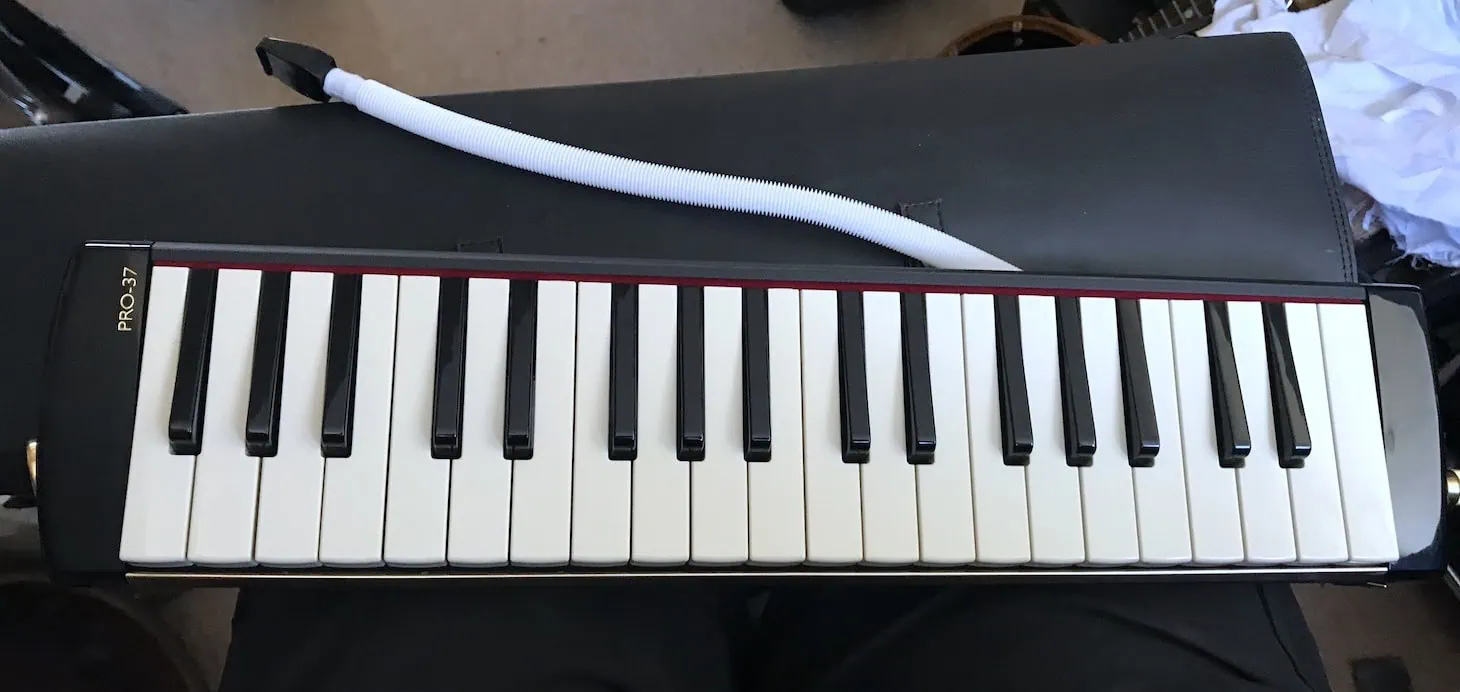
Suzuki PRO-37 Melodica
Immediately noticeable, we have a crazy-solid body build. Imagine a digital keyboard that mimics an acoustic piano as closely as possible, and that is what the PRO-37V3 looks like.
The entire body is made of brass, as well as the reeds. Both ends are encased in handcrafted walnut, and the body is carefully wrapped in vinyl. Red felt cushions the keys where they meet the body, just like a real piano.
Additionally, Suzuki soups up the PRO-37V3 with standard guitar features. First, they drilled in two plugs for a shoulder strap so you can carry it like a guitar. Secondly, they include an audio jack for live amplification!
This makes it an amazing tool for playing live.
Remember how I mentioned you can run melodicas through chain effects pedals into guitar amps to get some really cool dirty sounds? It's even easier when they have built-in amplification.
Personally, I find the internal amplification quite poor for studio use. I don't use the output as the primary signal — I use a microphone instead and process the internal signal separately. Though occasionally, I've experimented with running the line out into a lo-fi pedal called the Meris Ottobit Jr.
It was a match made in heaven because one of my criticisms of the built-in amplification is its very midrange sound that doesn't capture the low end well. Passing it through something with nice analog filter emulation and bit reduction makes for a cool combination. The Otto Bit also has a JFET input, which instantly gives it that transformer presence it sorely needs.
You don't need to use crazy bit-crushed distorted sounds through this pedal. Sometimes I just use it for the filter and slightly lower the sample rate — that's enough to make it sound cooler.
This reminds me of my main complaint about the Fender Telecaster: its pickup style makes it sound much thinner than the Stratocaster.
If you've ever played them back-to-back through an amp, you'll notice the Telecaster almost sounds like it's being bandpass filtered — it doesn't produce much low end or thump.
That's the same feeling I get when I hear the built-in output of the Suzuki Pro-37. But hey, that's our job as producers and engineers — taking weak elements and turning them into strengths.
Here's another studio tip: treat recording this Suzuki melodica as you would a Wurlitzer 200A electric piano. Run one output from the built-in amplification to a nice DI box or effects pedal, while capturing the acoustic dry signal with a warm vintage-style microphone. Then blend them together, treating the amplification almost like an effect send. This technique is incredibly effective.
It's similar to how I record a Wurlitzer — one microphone on the speaker and a direct out from the instrument's amplification DI.
I recommend using a vintage-style microphone when capturing this instrument, as it works well with melodicas in general. One microphone I've had excellent results with is the Avantone Pro CV-12.
Modeled after the legendary AKG C12 tube condenser microphone, this Avantone captures melodicas beautifully. This premium Suzuki sounds gorgeous as an acoustic instrument — it's just the amplification that thins it out.
Using a tube microphone works perfectly here — it smooths out the harsh highs while bringing up the low-mid harmonics for added warmth. Plus, this microphone is incredibly affordable at under $500, featuring excellent circuitry and genuine tube condenser architecture.
Other standard features you’d expect include a hand strap and spit valve. Interestingly, the spit valve has to be unscrewed. While it might not be convenient in the moment, this allows you to drain the instrument overnight.
Also, as a side note for those interested, it is tuned to A440 tuning.
Given the small market for melodicas, if you’re looking for a model for serious performance, the Suzuki PRO-37V3 is one of the best!
6. Hohner RASTA Melodica
Some people are casual fans of music genres. Then you have those other friends who are obsessed with everything about a genre.
If you are one of those people when it comes to reggae, then you might already know the melodica’s connection to reggae.
Enter reggae dub producer Augustus Pablo. A devout Rasta, Pablo used the melodica to further the sounds of his already diverse reggae tunes.
Although he may not be well-known outside reggae circles in 2023, he and John Batiste are the two most important musicians to make the melodica known worldwide.
With that, we come to our last product.
As a homage to Pablo, Hohner designed the 32-key RASTA melodica with black keys and a stylish design with red, yellow, and green. Reflecting the history of the African diaspora, these Pan-African colors represent heritage, wealth, and growth.
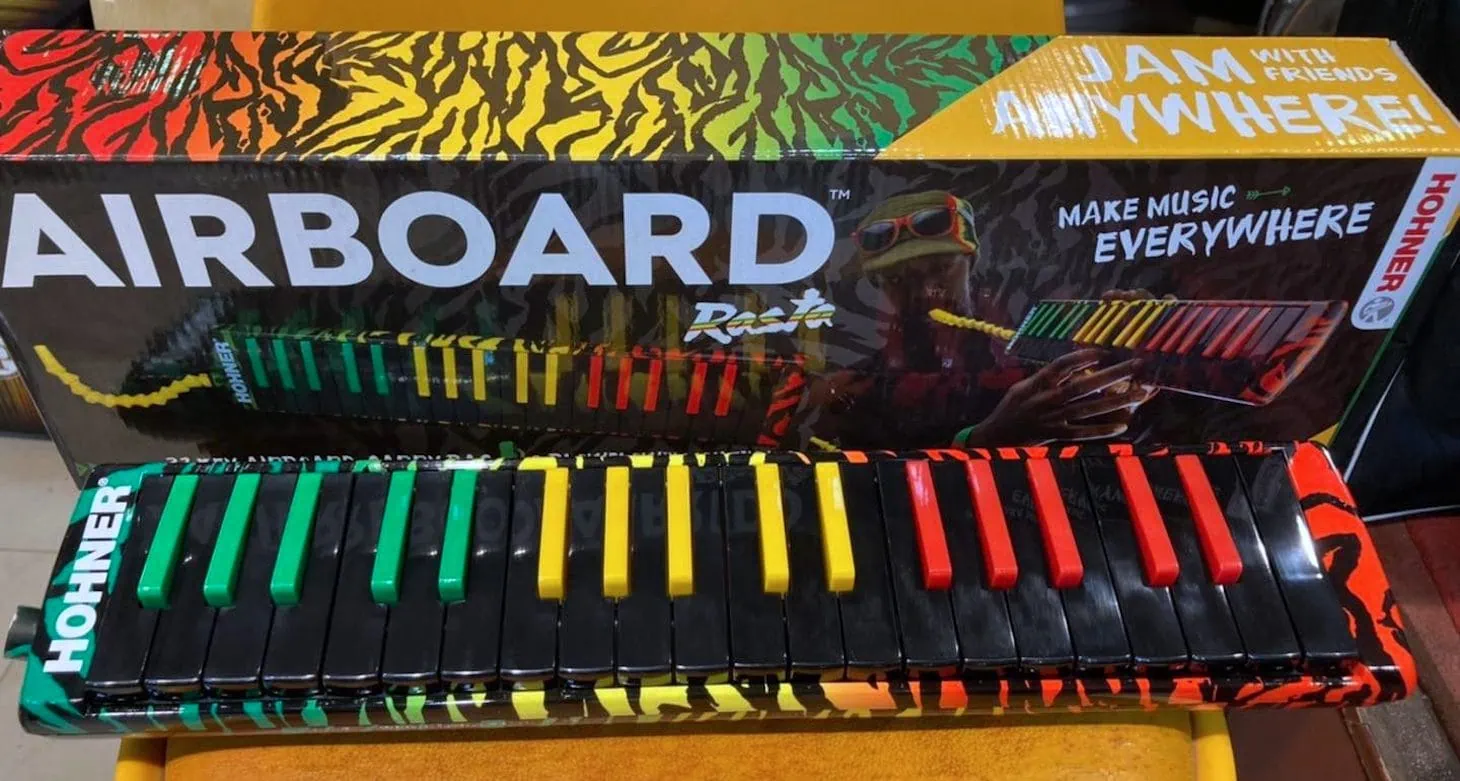
Hohner RASTA Melodica
Made from a durable plastic, the Hohner RASTA makes a remarkably full sound. Its design is very sturdy, making it one of the heavier melodicas on our list. It also includes a complimentary case, which they jokingly refer to as “stylin’.”
Another notable feature is its plastic mouthpiece tube. Instead of being freely bendable like other models, it has eleven “kinks” that you can use to make it keep whatever shape you want. While it’s a small detail, it does make playing it easier.
I saw the great Jamaican jazz pianist Monty Alexander playing this RASTA Hohner accordion live, and it sounded and looked incredible. It's primarily designed as a performance instrument, with its striking Jamaican flag colors and beaded wind tube. However, to be honest, the sound quality isn't exceptional — it's somewhat similar to the Instructor model.
While it has a bright tone, it lacks the warmth and smoothness of the Performer. Nevertheless, it performs well for traditional reggae and jazz. Its loud volume makes it a viable alternative to the Yamaha, especially if you're seeking both visual appeal and premium manufacturing.
The keys have an excellent feel, and I use this model primarily for melody playing. Chord performance is merely adequate, as it doesn't offer the dynamic range of the Suzuki or the Performer. Still, considering its affordable price, it's a solid all-around choice.
Like the Yamaha, this model is perfect for experimentation. You can modify the tone by adding felt to the keys, using rubber to dampen clicking sounds, or replacing the wind tube with different-sized rubber straws — similar to those used in talk boxes.
I know a producer who has heavily modified one in his studio, achieving some fascinating tonal variations. If you're planning to experiment with modifications, stick to the cheaper models — this one and the Yamaha are ideal candidates.
You could modify the Hohner Instructor, but it already has an excellent sound. I wouldn't use it as an experimental platform. Though it's less expensive, I love its mouthpiece response and the pleasant key sound, so there's no real need to alter it — though you could.
This flexibility for modification is one reason I often discuss processing these instruments — you can create interesting lo-fi effects without permanent alterations.
How Melodicas Work
While this isn’t entirely accurate, here’s the easiest way to describe a melodica: an instrument that sounds like a harmonica, but has piano keys instead of holes.
Melodicas look like really slim MIDI keyboards, but are acoustic. They have a bendable tube connected to one end, which is what the mouthpiece is attached to.
Each piano key has a metal reed attached to it, inside the mechanism. Whenever you blow and press down a key, your airstream is redirected across the reed and out the instrument.
Because the melodica uses reeds, it’s part of the woodwind family. But woodwinds have tons of diversity, since there are many ways to produce sound with reeds and air.
In my opinion, melodicas blend together the coolest features of different woodwinds. They borrow the portability of harmonicas, use multiple reeds like free-reed accordions, and use the expressiveness of human lungs like clarinets and saxophones.
Their main purpose in today's music is to allow keyboard players to dynamically sustain notes without needing extra accessories like a sustain pedal. Using breath to extend the melody or chord being played creates a hybrid instrument that combines qualities of both an accordion and a woodwind.
While you might think many modern music styles wouldn't benefit from this instrument, I frequently use it when layering with other sounds, including synth pads, as it adds a wonderful organic quality.
History of Free-Reed Instruments (Trust Me, this is Interesting!)
Most of the time, classical and pop instruments get all the attention – violins, pianos, guitars, all those guys. However, learning about the more obscure guys can really broaden our perspectives on musical possibilities and history.
Woodwinds are the oldest instruments in the world, and free-reed woodwinds go very far back. Although we might think they originate in Europe, they actually come from various regions of Asia!
The oldest free-reed instruments came from the Middle East and Southeast Asia. Ancient instruments like the Chinese sheng, Lao khene, and Japanese shō are still used today!
In turn, the reed organs and accordions we’ve come to know today were actually inspired by these Southeast Asian folk instruments. The first reed organs were pioneered in St. Petersburg and Copenhagen after instrument makers studied the sheng.
Unfortunately, many of these instruments lost popularity in Western classical music. But they lived on in rich folk traditions of various Slavic, Celtic, and Indian cultures.
All to say, even though the melodica might be seen as a novelty instrument, it still comes from a rich and fascinating background.
What to Know Before Buying a Melodica: The Four Price Ranges
Because the melodica is a newer instrument, a niche product, and dominated by few brands, its market is small and easy to assess.
The cheapest melodicas sell for anything between $20 and $50, on average. These are the models made for children and absolute beginners.
Given that, they are built more like toys and teaching tools than professional instruments. In fact, some countries use them for elementary education!
However, despite their quality, they still make for great first purchases. It is worth noting, though, that after several months, they will start going out of tune.
If you enjoyed playing it, they are cheap enough to buy a new one. Or, if you’re DIY-inclined, you could try tuning it yourself without risk of ruining something super expensive.
Second-tier melodicas will sell for between $50 and $100, on average. They might still be made out of plastic, but they will be sturdier and wear-resistant. They will also be optimized for faster control, allowing for more nuanced and technical playing.
Second-tier melodicas will also be hand-tuned, meaning they stay in tune longer. However, like any instrument, they wear down with time. When they get out of tune, you will want to learn how to tune them yourselves to avoid buying new ones.
After tier-two, you start getting into specialty, expensive models. Most notably, there is the Suzuki Hammond 44-key melodica, which I found selling second-hand on Reverb for over $500!
Tier-three models like the Suzuki Hammond will have all the perks needed for professional gigs: an extensive range (most stop at 37 keys), a slim and metal body, and an internal mic and jack.
Closing Thoughts
As with any unusual instrument, the melodica is often reduced to being called a “gimmicky,” novelty instrument. And while it’s most often used in schools and children’s playrooms, it’s certainly capable of so much more.
That's why I wanted to illustrate and provide tips for using these instruments across different genres, both live and with modern production styles. While using synths to create unusual sounds is still exciting, I've always loved applying lo-fi processing and distortion techniques to acoustic sounds.
This passion stems from my work as a film composer and sound designer, where we often use acoustic instruments as the foundation for creating ambient soundscapes. Reed instruments have always been my favorites — whether accordions, bandoneons, or melodicas — because they offer so much potential when processed into otherworldly sounds.
In a recent interview, Jon Batiste claimed its sonic capabilities are yet to be fully explored. If John Cage made serious music out of toy pianos, and Johann Johannsson wrote a concerto for an old IBM computer, who’s to say the melodica can’t be taken seriously?
If you’re interested in pursuing the melodica more, I hope this article was helpful in your continuing musical journey!

